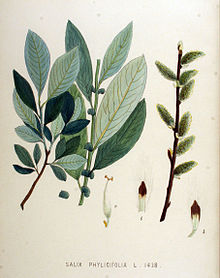Tea-leaved willow
| Tea-leaved willow | ||||||||||||
|---|---|---|---|---|---|---|---|---|---|---|---|---|

Tea-leaved willow ( Salix phylicifolia ) in Finland |
||||||||||||
| Systematics | ||||||||||||
|
||||||||||||
| Scientific name | ||||||||||||
| Salix phylicifolia | ||||||||||||
| L. |
The tea-leaved willow ( Salix phylicifolia ) is a species of willow ( Salix ).
description
The tea-leaved willow is a shrub that reaches heights of up to 4 meters. The bark of young twigs is initially slightly hairy, but later glabrous and of a shiny yellowish to brown color.
The leaves are divided into a petiole and a leaf blade. The leaf stalks are up to about 12 millimeters long. The simple, entire or slightly sawn leaf blade is 2 to 8 centimeters long and 1.3 to 5 centimeters wide and round, elliptical to ovoid or obovate. The underside of the leaves is green to blue-green, the upper side is glossy green, initially a bit hairy but later glabrous. Stipules are rare and, if present, small.
The strongly branched, short-branched catkins appear shortly before ( anthesis ) in May. They are mostly kittens 2 to 3.5 inches long. The kitten scales are two-colored, dark brown to blackish at the tip and lighter at the base. The flowers have two stamens . The anthers are yellow or somewhat reddish, the stamens glabrous and ingrown.
The number of chromosomes is 2n = 114.
Occurrence
The tea-leaved willow thrives in the Arctic zone as well as in the alpine altitude level analogous to the polar zones in Europe , as well as in the Mediterranean area , the Middle East and Western Siberia .
literature
- Jost Fitschen: Woody flora . 8th edition. Quelle & Meyer, Heidelberg 1987, ISBN 978-3-494-01151-6 .
Individual evidence
- ↑ Salix phylicifolia at Tropicos.org. In: IPCN Chromosome Reports . Missouri Botanical Garden, St. Louis
Web links
- Salix bicolor Willd., Two-colored willow. In: FloraWeb.de.
- Tea-leaved willow . In: BiolFlor, the database of biological-ecological characteristics of the flora of Germany.
- Description on slimwetwillows.co.uk (English)
- Distribution in the northern hemisphere according to: Eric Hultén , Magnus Fries: Atlas of North European vascular plants 1986, ISBN 3-87429-263-0 .
